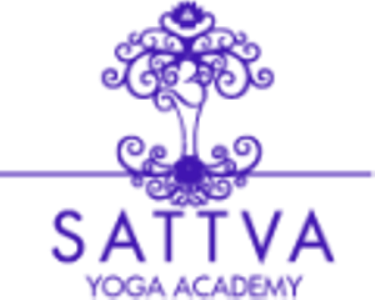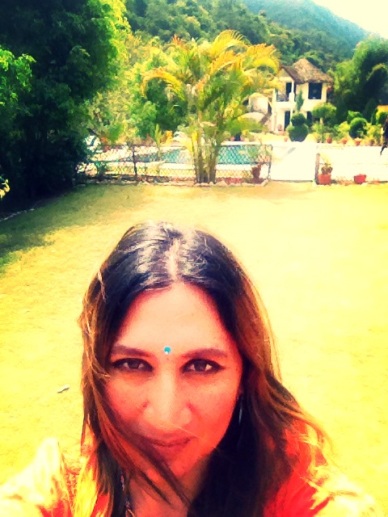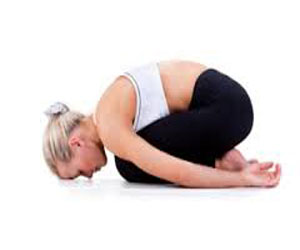Have you ever heard this type of comment in yoga teacher training class by yoga guru? “The posture/pose doesn’t start until you get your head on your knee.”
Sometimes people accept things (or say things) as gospel, automatically without question (because of some deep belief). If you really want your yoga to benefit you in the deepest way possible it is worth knowing that there are ways to fulfill the greatest intention of every single pose AND not (that’s NOT) be tied to the exact letter of the script.
So let’s see what actually happens when you follow scripted instruction too literally. What happens if you believe that “the pose doesn’t begin until your head is on your knee”

Why Is This Command Problematic?
Well, here’s the thing.
The intention is excellent – the idea being (and let’s takes “Standing Separate Leg Head to Knee” as the example) that you really do your utmost to complete the fullest expression of the pose.
But here’s the waiver. It’s YOUR fullest expression of the pose. It’s NOT to go TO the fullest expression of the pose. There is a BIG difference. The first honors and respects what you are able to do with best alignment. The latter will probably bypass your best outcome and will probably sacrifice your benefits. It could even because you damage.
The unconscious mind loves to respond to literal instructions. So if you don’t know what to ‘track’ for, your mind is actually going to have trouble ignoring the bad input. Especially if you go on auto-pilot for a few seconds, or stop paying attention (which happens ALL the time by the way). If you follow all commands without stopping to think or pausing for understanding, your “no matter what” style could get you into trouble!
Remember yoga is asking you to be conscious, hyper conscious even, not neglectful of what’s going on.
In other words, the scripted class, which teaches to the fullest expression of the pose to everyone in the room, implies that:
It’s the destination not the journey.
But what you’re after is to enhance the journey and not the destination.
So…
If interpreted literally, because of ambiguities and even the huge potential for different interpretations across the room, there is the distinct possibility of:
* A risk of injury
* Poor alignment at the expense of “doing a pose”
* Significantly reduced stretch and pose effectiveness
See more on this topic: – http://goo.gl/5RnhRs
So What IS Supposed To Happen?
Here are some of the reasons why getting “your head on your knee” is beneficial in this pose.
- It encourages a strong compressionfrom your chin to your hips, through your chest and abdomen.
Compressions such as this are super for a great many reasons. There is a ton of invisible work being done for you here!
The mysterious magic below the surface includes a stimulation that increases blood flow to the intervertebral discs (yes that does keep them healthy!). Another big plus is that your visceral organs get “stimulation by massage”.
- You get whole-system or systemic improvements:Your glands and organs ‘tone up’, which means better hormonal regulation, which in turn means better overall function. Yes!
- It’s an “energetic thing”– you effectively “complete a circle of energy lines” in the body.
- Helps with weight lossand shape changing, especially around the waistline when a good compression is achieved (especially because of 1. And 2. And when combined with some you-beauty backbending).
All of the above requires a ROUNDING of the spine in a forward compression – the objective being to get as much of a tight curl as possible.
And therein lies my issue with the statement … “The posture/pose doesn’t start until you get your head on your knee.”
Because you now have a potential conflict (because not everyone has the same abilities or flexibilities which even differ from day to day)
Do you:
- Focus on “an intense active stretch caused by rounding as much as possible”?
- Make the most common mistake? Do you work on getting your head to the knee and sacrifice the leg and hip alignment in the process?
- Or do you make the other most frequent and ‘lazy’ mistake, through lack of attention to the intention of the pose, by simply diving into the pose and … hey presto, minimal or no back rounding, just “head on knee”? You’d be surprised how often this occurs.
When in doubt, your mind will try to make your body do what it THINKS it needs to do. That doesn’t mean you are doing it correctly. There’s also a tribal or group dynamic happening here. It’s just an interpretation and in the hot room of a public studio you will often default to what everyone else has learned to do. Unfortunately, strict teaching that doesn’t allow for deviation means you bypass your own safety mechanisms and you learn to neglect your body’s own voice. That’s DANGEROUS stuff.
So points 2 and 3 (the most frequent common mistakes) often happen because of the way the class is delivered. The instructions are strong but they are also not entirely clear and the unconscious mind has to make sense of them. And that produces different results for different folk.
What your aim should be is to:
- Have the top of your forehead touching your “knee”(the actual touchdown point varies according to personal anatomy and flexibility);
- Your chin tucked in so stronglythat it could even feel a little awkward to breathe (this is why you’ll probably hear the words “choked throat”. It’s important to know that with time it can even be quite easy to breathe with your chin tucked in tight.
- Your gaze as you ENTERS, and during the pose, should be into your heartor higher. Most people will NATURALLY hear “put your head on your knee” and as a result actually LOOK at the knee on the way in. This is the biggest mistake. You can see that “head on knee” and “tuck the chin” don’t make it easy for the mind to work out exactly what to do. You have to train yourself to trust that in tucking your chin your head will land on the knee! Your knee is in a pre-determined place. You can trust that it won’t move by the time you curl up. 😉
What do you do if your forehead doesn’t make it to your knee?
Simple.
In Standing Sep Leg Head to Knee and in Floor Head to knee what you do is … Bend the knee to meet your forehead.*
* In Standing Head to Knee, you’ll keep working on balance and keep the lifted leg straight. Don’t get head to leg contact. Just hold off and work on best technique described above and in my resources. No prizes and no benefits for ‘cheating.’
Maybe you are a “big-boned” or plus-sized peep and even bending the knee up to meet your forehead won’t work. Look, many people do actually end up with their knee bent way up, and their chin next to the knee. But you have to try with the same intention of curling into a tight ball, tucking your chin and looking up into your heart.
Believe me, the posture HAS begun!
Sure you will have to bend the leg for contact – and some people can’t manage that – but your AIM has shifted.
As a good friend of mine has often said; “We don’t ‘do’ yoga, we ‘try’ yoga”.
Maybe one day your head will meet your knee.
More importantly, YOU will be getting more benefits than the person next to you whose mind have unconsciously reacted to the scripted command and have dived forward.
Oh their head could be on their knee … but take a look at which part of their head is contacting and check out their back – there will be less rounding due to the diving. Having a slightly rounded back and your face on the knee is doing almost nothing. It’s certainly not getting the outcome of this pose.
Poor alignment = poor benefits.
Read more to avoid injury- http://goo.gl/YHRkbt
Gabrielle











